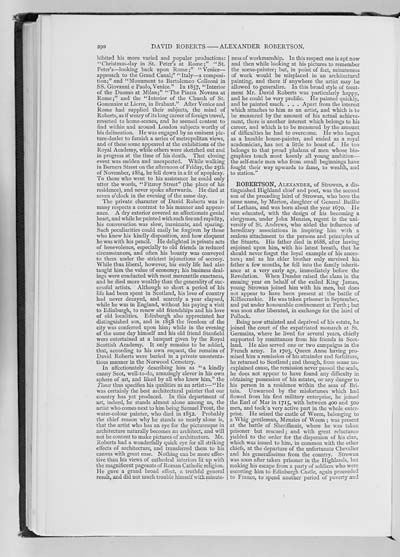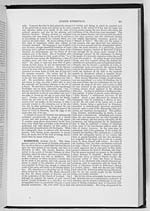Volume 3 > Half-Volume 5
(303) Page 290 - Robertson, Alexander
Download files
Individual page:
Thumbnail gallery: Grid view | List view

290 hibited his more varied and popular productions: "Christmas-day in St. Peter's at Rome;" "St. Peter's�looking back upon Rome;" "Venice� approach to the Grand Canal;" "Italy�a composi- tion;" and "Monument to Bartolemeo Colleoni in SS. Giovanni e Paolo, Venice." In 1857, "Interior of the Duomo at Milan;" "The Piazza Novana at Rome;" and the "Interior of the Church of St. Gommaire at Lierre, in Brabant." After Venice and Rome had supplied their subjects, the mind of Roberts, as if weary of its long career of foreign travel, reverted to home-scenes, and he seemed content to find within and around London subjects worthy of his delineation. He was engaged by an eminent pic- ture-dealer to furnish a series of metropolitan views, and of these some appeared at the exhibitions of the Royal Academy, while others were sketched out and in progress at the time of his death. That closing event was sudden and unexpected. While walking in Berners Street on the afternoon of Friday, the 25th of November, 1864, he fell down in a fit of apoplexy. To those who went to his assistance he could only utter the words, "Fitzroy Street" (the place of his residence), and never spoke afterwards. He died at seven o'clock in the evening of the same day. The private character of David Roberts was in many respects a contrast to his manner and appear- ance. A dry exterior covered an affectionate genial heart, and while he painted with such fire and rapidity, his conversation was slow, inanimate, and sparing. Such peculiarities could easily be forgiven by those who knew his kindly disposition, and how eloquent he was with his pencil. He delighted in private acts of benevolence, especially to old friends in reduced circumstances, and often his bounty was conveyed to them under the strictest injunctions of secresy. While thus liberal, however, his early life had also taught him the value of economy; his business deal- ings were conducted with most mercantile exactness, and he died more wealthy than the generality of suc- cessful artists. Although so short a period of his life had been spent in Scotland, his love of country had never decayed, and scarcely a year elapsed, while he was in England, without his paying a visit to Edinburgh, to renew old friendships and his love of old localities. Edinburgh also appreciated her distinguished son, and in 1858 the freedom of the city was conferred upon him; while in the evening of the same day himself and his old friend Stanfield were entertained at a banquet given by the Royal Scottish Academy. It only remains to be added, that, according to his own request, the remains of David Roberts were buried in a private unostenta- tious manner in the Norwood Cemetery. In affectionately describing him as "a kindly canny Scot, well-to-do, amazingly clever in his own sphere of art, and liked by all who knew him," the Times thus specifies his qualities as an artist:�"He was certainly the best architectural painter that our country has yet produced. In this department of art, indeed, he stands almost alone among us, the artist who comes next to him being Samuel Prout, the water-colour painter, who died in 1852. Probably the chief reason why he stands so nearly alone is, that the artist who has an eye for the picturesque in architecture naturally becomes an architect, and will not be content to make pictures of architecture. Mr. Roberts had a wonderfully quick eye for all striking effects of architecture, and transferred them to his canvas with great ease. Nothing can be more effec- tive than his views of cathedral interiors lit up with the magnificent pageants of Roman Catholic religion. He gave a grand broad effect, a truthful general result, and did not much trouble himself with minute- ness of workmanship. In this respect one is apt now and then while looking at his pictures to remember the scene-painter; but, in point of fact, minuteness of work would be misplaced in an architectural painting, and there if anywhere the artist may be allowed to generalize. In this broad style of treat- ment Mr. David Roberts was particularly happy, and he could be very prolific. He painted quickly, and he painted much. . . . Apart from the interest which attaches to him as an artist, and which is to be measured by the amount of his actual achieve- ment, there is another interest which belongs to his career, and which is to be measured by the amount of difficulties he had to overcome. He who began as a humble house-painter, and ended as a royal academician, has not a little to boast of. He too belongs to that proud phalanx of men whose bio- graphies touch most keenly all young ambition� the self-made men who from small beginnings have fought their way upwards to fame, to wealth, and to station.'' ROBERTSON, ALEXANDER, of Strowan, a dis- tinguished Highland chief and poet, was the second son of the preceding laird of Strowan, who bore the same name, by Marion, daughter of General Baillie of Letham, and was born about the year 1670. He was educated, with the design of his becoming a clergyman, under John Menzies, regent in the uni- versity of St. Andrews, who aided the influence of hereditary associations in inspiring him with a zealous attachment to the persons and principles of the Stuarts. His father died in 1688, after having enjoined upon him, with his latest breath, that he should never forget the loyal example of his ances- tors; and as his elder brother only survived his father a few months, he fell into the family inherit- ance at a very early age, immediately before the Revolution. When Dundee raised the clans in the ensuing year on behalf of the exiled King James, young Strowan joined him with his men, but does not appear to have been present at the battle of Killiecrankie. He was taken prisoner in September, and put under honourable confinement at Perth; but was soon after liberated, in exchange for the laird of Pollock. Being now attainted and deprived of his estate, he joined the court of the expatriated monarch at St. Germains, where he lived for several years, chiefly supported by remittances from his friends in Scot- land. He also served one or two campaigns in the French army. In 1703, Queen Anne having pro- mised him a remission of his attainder and forfeiture, he returned to Scotland; and though, from some un- explained cause, the remission never passed the seals, he does not appear to have found any difficulty in obtaining possession of his estates, or any danger to his person in a residence within the seas of Bri- tain. Unwarned by the misfortunes which had flowed from his first military enterprise, he joined the Earl of Mar in 1715, with between 400 and 500 men, and took a very active part in the whole enter- prise. He seized the castle of Weem, belonging to a Whig gentleman, Menzies of Weem; was present at the battle of Sherifrmuir, where he was taken prisoner but rescued; and with great reluctance yielded to the order for the dispersion of his clan, which was issued to him, in common with the other chiefs, at the departure of the unfortunate Chevalier and his generalissimo from the country. Strowan was soon after taken prisoner in the Highlands, but making his escape from a party of soldiers who were escorting him to Edinburgh Castle, again proceeded to France, to spend another period of poverty and
Set display mode to:
![]() Universal Viewer |
Universal Viewer | ![]() Mirador |
Large image | Transcription
Mirador |
Large image | Transcription
Images and transcriptions on this page, including medium image downloads, may be used under the Creative Commons Attribution 4.0 International Licence unless otherwise stated. ![]()
| Biographical dictionary of eminent Scotsmen > Volume 3 > Half-Volume 5 > (303) Page 290 - Robertson, Alexander |
|---|
| Description | Spine title: Half-Vol. V. Macadam to Smith. |
|---|---|
| Description | Volume III. Contains names alphabetically from Macadam to Young. |
|---|

